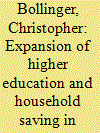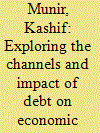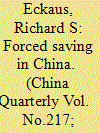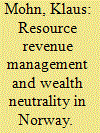|
|
|
Sort Order |
|
|
|
Items / Page
|
|
|
|
|
|
|
| Srl | Item |
| 1 |
ID:
192901


|
|
|
|
|
| Summary/Abstract |
We investigate the results of the Israeli pension reform that started at the beginning of 2016. This reform created aged, adjusted pension plans that are aimed to fit better the different age categories and protect the over 60 years old savers from the occurrence of a financial crisis close to their retirement. We find that all the over 60 years old funds have outperformed the financial market according to their preferred level of risk. On the other hand, because the financial market blossomed in recent years, they lost a yearly potential return of 1.64%. The pension tracks for under 50 years old savers have gained an extra of 0.73% return per year; however, not all funds in this age category have outperformed the market benchmarks. The reform did not have a substantial impact on the 50–60 years old track since the risk ingredient has not changed dramatically.
|
|
|
|
|
|
|
|
|
|
|
|
|
|
|
|
| 2 |
ID:
187807


|
|
|
|
|
| Summary/Abstract |
We examine whether access to higher education impacts household saving rates. A 2-period model of household saving decisions demonstrates why increased college opportunities induce households with children to save more. We examine this theory using survey data from Chinese households during the unprecedented education expansion. Using estimates of the change in the expected probability of college attendance, we estimate the effect on household saving rates by comparing households before and after the reform. We find that a 10-percentage point increase in the probability of going to college raises the saving rate by 5.9 percentage points.
|
|
|
|
|
|
|
|
|
|
|
|
|
|
|
|
| 3 |
ID:
161486


|
|
|
|
|
| Summary/Abstract |
The objective of this study is to analyse the effect of debt on economic growth as well as the channels, that is, investment, total factor productivity (TFP), interest rate and saving channel through which debt affects economic growth in South Asian countries. The study uses growth model based on conditional convergence and augments to include debt. Panel data of four South Asian countries from 1990 to 2013 at annual frequency are utilized and fixed effect model is used for estimation. The results of the study showed that inverted U-shaped relationship exists between debt and economic growth in South Asian countries. However, the most important and significant channel through which debt affects economic growth is private and public investment as well as TFP. Reducing debt accumulation alone will not rectify the problem unless the supplementary macroeconomic policies are made sound; therefore, there is a dire need to improve macroeconomic policies, good governance and elimination of structural distortions.
|
|
|
|
|
|
|
|
|
|
|
|
|
|
|
|
| 4 |
ID:
131955


|
|
|
|
|
| Publication |
2014.
|
| Summary/Abstract |
The explanation offered here for the high rates of saving in China is that much of the saving has been "forced" in two Benthamite senses. Involuntary saving, the first of Bentham's meanings, includes taxes which finance investment. These have made up more than half of the total savings in China in recent years. There is also forced saving in China in the form of Bentham's second sense, conduced saving, resulting from bank loans which have financed investment. While the existence of a savings glut has been suggested for China, a better characterization would be that it has had a high rate of investment.
|
|
|
|
|
|
|
|
|
|
|
|
|
|
|
|
| 5 |
ID:
090793


|
|
|
|
|
| Publication |
2009.
|
| Summary/Abstract |
China exhibits above average savings and below average consumption as shares of total economic activity when compared with other countries. At the same time, to create more balanced growth at home and rebalance key bilateral trade and capital flow relationships, China's leadership is trying to increase domestic demand. To complement studies that investigate the high rate of savings in China, this study focuses on the variation in consumption as a share of GDP across provinces between 1979 and 2004. Drawing on well-established consumption theories and work done on savings behavior in China, this paper develops an empirical investigation of the variables hypothesized to influence the pattern of consumption across regions.
|
|
|
|
|
|
|
|
|
|
|
|
|
|
|
|
| 6 |
ID:
072606


|
|
|
|
|
| Publication |
2006.
|
| Summary/Abstract |
The present paper is an attempt to define the contours of the right macroeconomic strategy for China. In a nutshell, we believe that the package includes a decrease in saving, with a focus on private saving, an increase in the supply of services, in particular health services, and an appreciation of the RMB. This is why we refer to this strategy as a "three-handed approach": action on the fiscal and budgetary front, accompanied by currency revaluation. We start by asking how the Chinese economy got to where it is, what the strategy has been since the beginning of the reforms, and what the main characteristics of the economy are today. We then ask what is the desirable path for the future, and which are the main policy trade-offs implied by such a path. Finally, we put the various pieces together to describe what we believe is a consistent policy package.
|
|
|
|
|
|
|
|
|
|
|
|
|
|
|
|
| 7 |
ID:
150009


|
|
|
|
|
| Summary/Abstract |
An important idea behind the Norwegian oil fund mechanism and the fiscal spending rule is to protect the non-oil economy from the adverse effects of excessive spending of resource revenues over the Government budget. A critical assumption in this respect is that public sector saving is not being offset by private sector dis-saving, which is at stake with the hypothesis of Ricardian equivalence. Based on a framework of co-integrating saving rates, this model provides an empirical test of the Ricardian equivalence hypothesis on Norwegian time series data. Although the model rejects the strong-form presence of Ricardian equivalence, results indicate that the Norwegian approach does not fully succeed in separating spending of resource revenues from the accrual of the same revenues.
|
|
|
|
|
|
|
|
|
|
|
|
|
|
|
|
| 8 |
ID:
139003


|
|
|
|
|
| Summary/Abstract |
The recent global financial crisis has generated substantial research interest in the relationships among savings, inequality and global imbalances. Our study examines the causes of global imbalances by analysing the relationship between income inequality and economic performance and the relationship between savings imbalances and economic instability. We identify a positive link between savings and inequality whenever savings are allocated through the financial market to investment firms for production. However, this relationship becomes negative when non-saving households borrow savers' funds for consumption. Our findings suggest that income inequality should be reduced in both China and the US to mitigate global imbalances.
|
|
|
|
|
|
|
|
|
|
|
|
|
|
|
|
| 9 |
ID:
178483


|
|
|
|
|
| Summary/Abstract |
China's current account surplus declined significantly from its peak of nearly 10 percent of GDP in 2007 to less than 1 percent in 2018. The new pattern offered fresh evidence for our understanding of China's current account dynamics. In this paper, we used flow of funds data to gauge its underlying driving forces. Specifically, by employing index decomposition analysis, we decomposed the current account from the perspective of savings and investment into three sectors: the household, corporate, and government sectors. We found that the decline in China's current account ratio was first driven by cyclical factors, i.e. weak corporate saving growth induced by the economic slump in 2009 as well as the following massive corporate investment bolstered by the government stimulus plan. However, such cyclical factors quickly subsided, and the subsequent current account balance reduction was later supported by structural factors, i.e. household savings declined enduringly and the Chinese government switched to a more expansionary fiscal policy. There are three possible explanations for the structural movement: reduced precautionary saving due to higher social security coverage ratio, lower corporate profits as a result of economic slowdown, and a twin deficit due to the government's more relaxed fiscal stance. The new facts, however, were not consistent with other current account theories focusing on long-term aspects of the saving–investment account puzzle, especially those relating to China's special demographic characteristics.
|
|
|
|
|
|
|
|
|
|
|
|
|
|
|
|
|
|
|
|
|